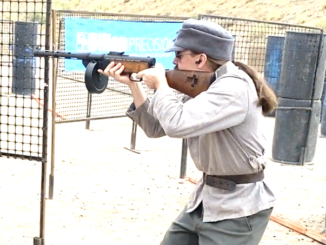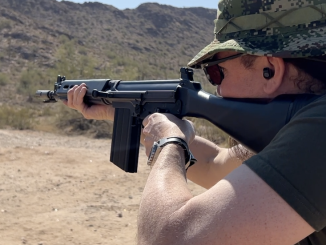This Ferguson rifle sold for $96,000.
Captain Patrick Ferguson was a British officer who designed and patented a breechloading rifle in 1776, which would actually see service in the American Revolution at the Battle of Brandywine. Ferguson presented two rifles to the British military for consideration, one of them being this specific gun. In a shooting demonstration on a windy, rainy day he convinced the Board of Ordnance of the viability of his rifle, and a field trials was set in motion. One hundred Ferguson rifles were made for the Crown, and Ferguson was detached form his Regiment to be given command of a company of specially trained elite riflemen. His men were drilled in accurate shoot as well as use of the bayonet, they were organized in small groups to make use of cover and concealment, and they were fitted with green uniforms to blend into the terrain. This unit deployed to the American colonies in 1777, and saw action in the Battle of Brandywine.
Unfortunately for Ferguson and his ideas, the unit didn’t make any particularly notable impact on the battle, although not by any fault of their own. Worse, Ferguson was wounded, and because the unit was so heavily dependent on him it was disbanded while he recuperated. He did see service again at the Battle of King’s Mountain, where he was killed in action. This particular Ferguson rifle was made by the noted London gunsmith Durs Egg, and is one of the two guns presented to the Board of Ordnance that began the whole series of events.




Saw one of these at Kings Mountain state park. Seemed like its biggest drawback was flintlock ignition. I have been quite surprised that this idea was never tried as a caplock in the pre-metalic cartridge days.
The price would probably have scuttled any larger project. Still, had Ferguson survived, or the guns gotten prominent use, there’s no reason it shouldn’t have gone forward as a specialist piece. Presumably with some significant reinforcing through the breach end.
While the Ferguson was essentially a failure as a military rifle, Durs Egg did a nice business making sporting Fergusons for the rest of his days as a gunmaker. They can generally be distinguished by a better grade of fit and finish, plus often having a retracting bayonet under the barrel. Since the breechloading Ferguson did not require a ramrod, Egg added the bayonet for hunting use on such animals as wild boar, which if not brought down with the first shot would likely charge before the hunter could reload.
One of the things about that trials session that convinced the British Army that Ferguson “had something” was not only that he kept firing even in a pouring rain, but at one point he deliberately let rainwater in the breech, thoroughly wetting the powder. He then cleaned it out, reloaded with fresh, dry powder, and was shooting again in about a minute. You couldn’t do that that fast with any muzzle-loader.
Ferguson’s British patent is No. 1139 of the year 1776, according to W.H.B. Smith. In it, he refers specifically to the two previous versions of the vertical screw breech, the (British) Warsop and the (French) Le Chaumette, and states that he is patenting only “an improvement in breech-loading arms”. His improvement was the captive breech screw with the relief grooves; the Warsop and Le Chaumette screws were both “loose”, and could be dropped and lost if you fumbled the drill, and they lacked the vertical recesses that not only allowed powder residue to accumulate out of the way of the screw threads, but also acted as scrapers to get the crud out of the threads to begin with.
Also, while the Warsop and Le Chaumette used typical screw threads of about 1/10 pitch, meaning it took several rotations to open or close the breech, Ferguson used a much steeper 3/12 or 1 in 4 pitch to get the breech open and shut with only one full 360 degree rotation.
As for Ferguson being allowed to form his own company of riflemen, at least he got off easier than Hiram Berdan did with the Union Army during the American Civil War. When Berdan, one of the best rifle marksmen on Earth at the time (just as Ferguson had been a generation before) proposed the unit that became known as “Berdans’s Sharpshooters”, he was given a commission and told he was welcome to form and equip such a unit- providing that he paid for everything himself, other than rations and the men’s pay. Which he did.
At least Ferguson didn’t have to foot the bill for his company.
cheers
eon
HA! Ferguson’s idea worked a lot better than most solutions of the day. And for all concerned, the best way forward isn’t always what is deemed “state-approved.” About a century and then some decades later, Andre Chapelon’s personally tinkered and personally assembled steam locomotives made the top French state railway executives green with envy. This hot-shot of a backyard engineer made locomotives that could outperform practically the entire FLEET of trains designed by state-employed lackeys, whether in horsepower or speed or even BOTH at the same time! Ain’t THAT a kick in the teeth?
After Ferguson was wounded, if not before, he turned mean. He served in the Carolinas with Tarleton, who quite enjoyed killing prisoners and civilians. (Dunno if T. actually burned churches with the congregations inside, but some say he did.) If Ferguson didn’t always go to those extremes, he certainly hated the damn’d rebel colonials. I guess getting your right elbow smashed by a musket ball can sour your mood.
His tale ends with 4 Yankee rifle balls in him, fired, of course, from technologically backward Pennsylvania rifles.
The American Revolution’s Southern theater was a nasty war all around. Tarleton’s Green Dragons was a unit manned by Loyalists. Neighbor fighting neighbor often makes for brutality.
Link to shooting video-
https://www.forgottenweapons.com/ferguson-breechloading-flintlock-video/
I built one of these in 1974 for the bicentennial in ’76.
It now belongs to the secretary of the Bluehills shooting club Tasmania, Australia.
Actually real quite easy to make with tooling from the 1970’s not so in the in the 1770’s.
The critical piece is the breach plug and for those who wish to know it is a 3/4″, 10 start, 1″ lead thread cut on a three degree taper.
With modern quality black powder it does not size due to fouling.
Some wonderful engineering designers out there for any enthusiast to try and replicate.